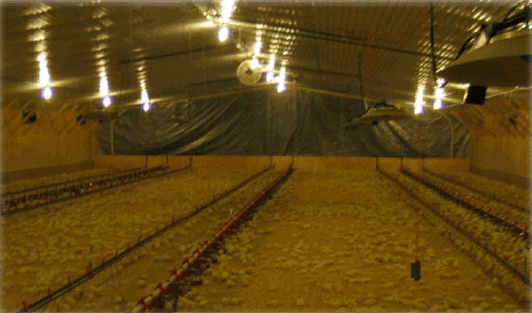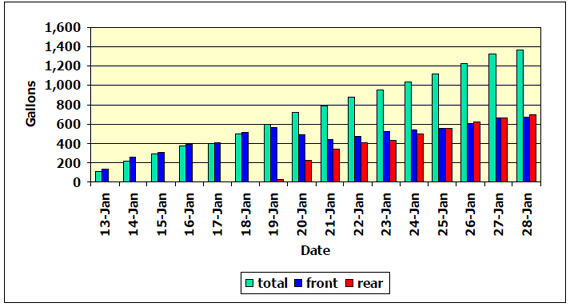



Factors to Consider when Transitioning Broilers from Half-House to Full-House
Keeping birds evenly distributed is an important aspect of broiler management that helps to get the full performance potential from the birds, according to Brian D. Fairchild, Extension Poultry Scientist with the University of Georgia. He focuses on temperature, feed & water, light intensity and air quality.When brooding broilers, growers can utilise either the partial house or full house brooding method. Partial house brooding uses half of the house square footage and can utilise either half house or centre house areas. With half house brooding, a single brood curtain suspended from the ceiling and located at the center of the house is lowered and chicks are placed in the end of the house that includes the tunnel inlet. Centre house brooding uses two curtains that allow broilers to be brooded in the centre of the house. Both methods of partial house brooding reduce heating requirements by utilizing half of the house capacity. Chicks are kept in the brood area for the first seven to 14 days. The time that birds are kept in the brood area depends on bird size, environmental temperatures and litter conditions.
Birds should be turned out to maintain proper bird density requirements based on guidelines provided by the integrator or primary breeder companies. In many cases, litter conditions dictate when birds should be given access to the full house. Sometime between 10 and 14 days, the curtains are raised and half of the birds are allowed to move to the non-brood area. Getting the birds to move to the non-brood end can be challenging at times. One important component in successful flock management is to make sure that the birds are evenly distributed with half the birds in the front of the house and half in the rear. There are a number of factors that can affect how well and easily birds move into the non-brood area. In simplest terms, a uniform environment should be provided throughout the house.

Temperature
In cooler months, the temperature in the non-brood area can be 20-30°F lower than that of the brood chamber. Birds will move into the non-brood area more slowly if the air temperature and floors are cooler. Pre-heating the non-brood end prior to giving birds access should be started about two to three days before moving. Many producers will switch their minimum ventilation fans to fans in the rear of the house to pull warm air from the brood end into the non-brood end. This practice can help reduce fuel usage, but care should be taken to prevent condensation issues.
Feed and Water
Feeders and drinkers should be set at the appropriate height and water pressure for bird age in both the non-brood and brood areas of the house. All feeders should contain feed. If the water or feed is not available, birds will not move to the non-brood area.
Light Intensity
Birds are more active in high light intensities than low light intensities and some people have tried to use this fact to entice birds to move to the non-brood end sooner. Some growers have used higher light intensity in the rear of the house and others have tried using lower light intensities. The method that works the best is to provide a uniform light intensity throughout the house. Bird activity is directly correlated with light intensity. The higher the light intensity, the more active the birds will be. If light intensity is lower in the non-brood end, birds will tend to sit more as they move into this area. If, however, the light intensity is lower in the brood end, birds might be attracted to the brighter light in the non-brood end. This may not be the best programme either because the broilers will be more inclined to sit in response to the lower light level in the brood end rather than move.
Air Quality
Typically, litter amendments used to reduce ammonia levels are only applied in the brood area prior to bird arrival. By the time birds are ready to be given access to the non-brood area, ventilation rates should be high enough to keep ammonia concentrations below 25ppm. In some cases, many of the side wall inlets in the non-brood end may be closed to direct more fresh air to enter into the brood area while the brood curtain is down. As birds move into the back of the house, side wall inlets should be opened to allow fresh air to enter the brood area diluting the ammonia that may have built up and controlling relative humidity and subsequent litter moisture.
Other Strategies
Other things that have been tried with varying degrees of success is to enter the house through a door located at the front near the evaporative cool cell pads and walk to the rear. This will drive some of the birds to the non-brood area. This will not provide immediate results but slowly encourage birds to move in the direction of the non-brood area. Some people have tried placing eight to 12 buckets in the non-brood area to play on bird curiosity. One theory on why this method may work is that birds have a natural tendency to investigate objects. Using the buckets may be utilising that instinct as a management tool. Another method, utilised to get the birds evenly distributed between the front and back of the house, involves placing a small migration fence, usually a black 4” pipe in the middle of the brood area and then dividing the chicks in half as they are placed in the house. When the brood curtain is raised, all of the birds on the side of the pipe closest to the non-brood area are moved in that direction.
Determining the Progress of Bird Transition to the Non-Brood Area
The simplest way to monitor the numbers of birds in the brood and non-brood areas is to install two water meters for the house and monitor water consumption in the front and back. It is difficult to quantify visually whether or not small birds are evenly distributed between the front and back of the houses. It is easier to tell uneven distribution when the birds get bigger but by then, it is difficult to move birds. Using water meters allows people to objectively determine when they have the birds evenly divided between the front and rear of the house. When the water consumption in the front and back of the houses becomes equal is the time to put up migration fences (Figure 1).

Conclusion
Getting birds evenly distributed will reduce competition for feed and water space. It will help keep litter drier by not concentrating too many birds in one area of the house.
Even bird distribution will keep bird heat distributed throughout the house. Birds that are evenly distributed will have better weight gains and better feed conversion than birds that are not evenly distributed. In cold weather, houses with even bird distribution will have more even heater run times among the different heat zones. If birds are not evenly distributed, the zones with few birds will run more than zones with birds at a higher density.
Keeping birds evenly distributed is an important aspect of broiler management that helps to get the full performance potential from the birds.
January 2012








